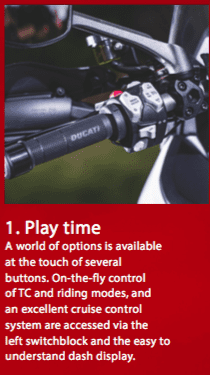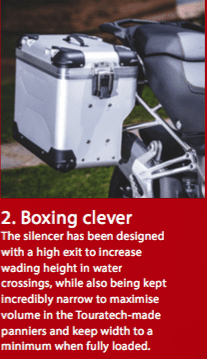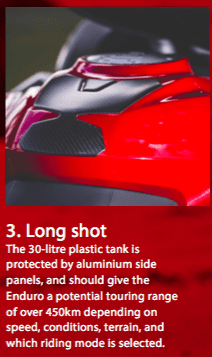Flying over the European Alps towards my island destination of Sardinia and staring down at the vast semi-wilderness with boyish awe seemed a fitting way to approach the world launch of Ducati’s Multistrada Enduro. There’s no better way of realising the appeal of adventure riding than looking over the potential areas of exploration and contemplating just how much you are missing at 40,000 feet, doing 1000 km/h.
To a certain extent this is also true of adventure riding itself. The faster and further you go, the more you miss. Which is why time should be taken between ripping up trails with your knobblies to don walking boots and explore the country at a more intimate level. After all, what’s the use in getting yourself ‘out there’ if you don’t stop, give your horse a rest, and cop a nose-full of nature close up?
And now, finally, the single-minded Ducatistas can do just that on their own dirty desmo – the Multistrada Enduro. They can pull on their Italian leather adventure boots, fill their Camelbak with Campari, and take all the wrong roads to all the right places. At the same time, those of us already entrenched in the dirty side of motorcycling have an option to inject a bit of Italian style into our bushcraft and bulldust-bashing.
I’ve been just a little excited about the arrival of Ducati’s Multistrada Enduro, even before I received an unexpected last-minute invitation to the bike’s world launch. I love the concept of a Ducati – with all the exclusivity and desirability the name entails – that I can thrash over dirt roads, scratch to buggery, drop, dent, and generally damage, then leave parked while I roll out a swag on a starry night far far away from the nearest sealed road. I guess I just like the idea of expensive and exclusive things which are born to be abused. And I’m chuffed I got to drift, jump and slam a brand new $30K+ Multistrada around Sardinia without fear of having to pay for the consequences.
The history
Haters who believe Ducati has no place in the dirt, and doubters who say they haven’t the pedigree to build real off-roaders, are in for a serious climb down. For a start, we mustn’t forget that Ducati power has won the biggest off-road show on Earth, twice.
The Cagiva Elefant won the 1990 and ’94 Paris-Dakar rallies with 900cc of air/oil-cooled Ducati desmo L-twin at its heart. And just to make it a tricolore whitewash, it was none other than Italian Dakar legend Edi Orioli at the bars.
But Ducati hasn’t just stood on its brittle, faded laurels to prove it is worthy of more than a cameo in our dirty dreams. Top level off-road riding talent, and the expertise of Touratech – the world’s top adventure gear company – were drafted into the design and durability testing program to guide development of the Enduro and its accessory options down the right track.
Some of these off-road test riders were also group leaders at the world launch, including senior test rider Alessandro Valia, who came from a motocross background, but more recently was an Italian national champion on a Panigale 1199R, and also raced WSBK.
Long-time Ducati press launch coordinator Beppe Gualini is a Paris-Dakar veteran with a record number of African rallies under his belt, racing both as a factory rider and privateer for many different manufacturers back in the days when big twins ruled the desert.
The brief
Although the Multistrada already had some fairly tidy manners for hitting graded gravel roads, Ducati was always focused on the Enduro version being much more than a mild off-road makeover. The Enduro model was developed in parallel with the standard Multistrada from the very beginning, and this has a lot to do with why the standard bike is so robust, and can handle minor gravel detours with ease. Even so, the Multistrada Enduro is a very off-road focused variant, and has 266 model-specific parts to make the transformation from the standard Multistrada into a true adventure tourer.

The chassis
Built to be longer, stronger and stiffer than the standard Multistrada, the Enduro has gained the stability, durability and accuracy needed to guide a fully fuelled 254kg, 1200cc, 118kW motorcycle across uneven terrain. The new longer double-sided swingarm does a lot of the legwork towards off-roading the chassis, but the new long-travel fork with its leading axle design also contributes to the extra 65mm of wheelbase by adding 16mm to the fork offset. This extra offset and a shallower head angle, out a single degree to 25o, has increased steering trail to 110mm, all resulting in more deflection-resistant front-end geometry. There is also a steering damper as a back- up should things get, literally, out of hand.
Being a heavyweight hauler, the Enduro tends to flatten rather than float over obstacles, and often requires all its 200mm of front and rear suspension travel to do so. But the latest EVO version of Ducati’s semi-active electronically adjusted Skyhook Suspension – standard fitment on the Enduro – does a sterling job of making 200mm of travel feel more like 250mm at times.
Flicking through the riding modes and their corresponding default suspension settings is like being able to swap bikes at any point of your ride, only by touching a button rather than swapping keys. Not that you even need to handle a key until it’s time to fill up – with hands-free ignition you can just leave it in your pocket and ride away.
Although serious air time will get the Enduro’s belly kissing the ground, and sometimes even excavating substantial trenches, its 205mm of undercarriage clearance, a sturdy angled aluminium skid plate, and 136Nm of brute force will barge you over most obdurate low-lying trail obstructions. Just don’t run your tyre pressures too low, because there’s a whole mother lode of downward force working on those airbags when the Enduro is at full steam. The tubeless 19- and 17-inch wire-spoked wheels are things of great strength and beauty, and certainly seem up to the abuse, but split tyre sidewalls aren’t a very groovy thing when you’re out back of beyond. This isn’t
the bike to be trying 10psi in the rear coz your mate reckons it works on his 250 Husky. No siree Bob.
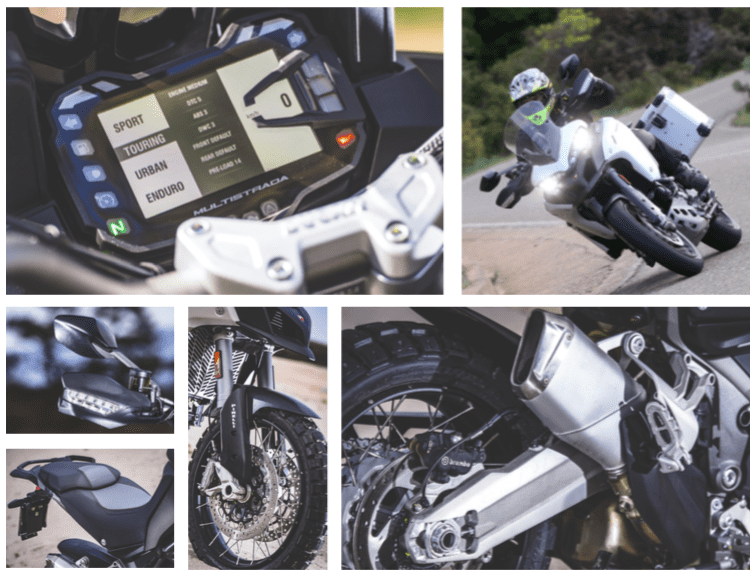
The brakes
Great brakes. ’Nuff said.
Okay, so some may even say they’re too good. Brembo M4s biting onto two 320mm floating discs is superbike spec stopping power, not what you usually find covered in mud. But that’s what ABS is for: so some can dull it down and stay safe, and I can switch it off, lock ’em up, and howl like a loon. Happy days!
Oh, and the rear brake has been given a bigger disc than the standard Multistrada, to cope with all those skids we’ll be doing on the gravel. Good move.
The engine
At the heart of Ducati’s first dalliance with true adventure riding under its own name, is basically the same Desmodromic Variable Timing (DVT) equipped 1198.4cc Testastretta engine found in the standard Multistrada. The major specification change for the off-road focused Enduro has been made purely in the area of gearing. The Enduro receives a new, lower first gear ratio, and all the gears are also lowered with a reduction in the final drive ratio by adding three teeth to the rear sprocket. The biggest difference obviously is in first gear, where bike speed has been reduced by 20 per cent for the same rpm compared to the standard Multistrada. And there is more torque delivered to the rear wheel at lower rpm right the way through the gears.
With a rev limiter that doesn’t call quits until past 10,000rpm, it is a high revving engine for a 1198.4cc dirtbike. But with 100Nm of torque on tap from as early as 3750rpm, building to 136Nm at the dizzy heights of 7500rpm, there’s a whole lot of fulsome fatness produced by the Enduro’s Bolognese grunt generator. So there’s never any real need to explore the upper rev range, other than for the sheer pleasure of hearing it sing.
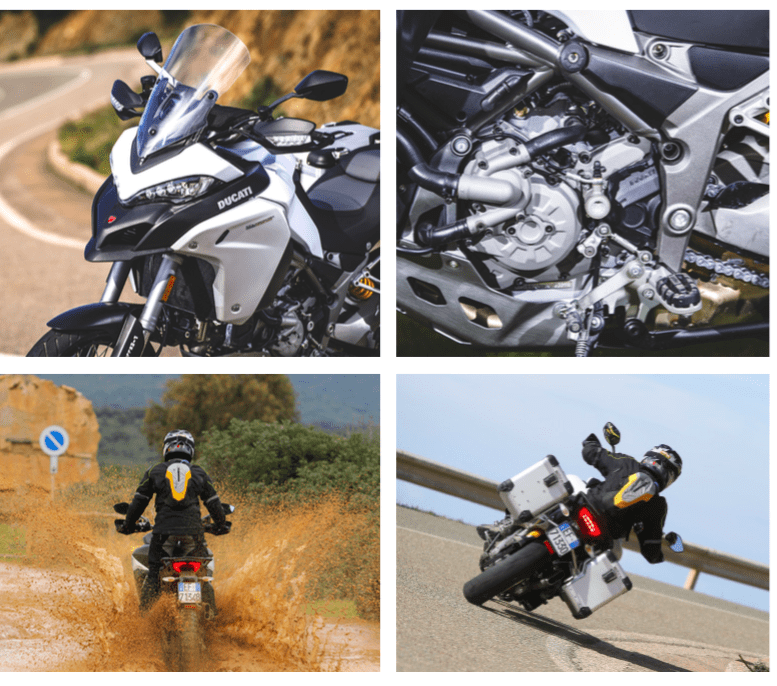
The ride
Selecting Touring mode and hitting the tar for the first loop of the launch, the Enduro instantly felt distinct from its road-focused Multistrada sisters. The narrow 19-inch front tyre and tweaked front- end geometry give a light-footed yet slower steering feel than is common for a dirtbike ridden on tarmac. I took this as a good omen for off-roadability, and started getting impatient to have a crack at tasting some Sardinian soil between my teeth.
But not before I’d flipped it into Sport mode and had a proper fang on the bitumen. This stiffens up the suspension considerably and gives the throttle response some attitude, and actually turns the Enduro into quite a handy tarmac tearer. Not in the realms of a Pikes Peak Multi’ on 17-inch stickies, but good enough to give your road-marooned mates a scare before you give them the V salute and disappear up a dirt track with a grin like the Cheshire Cat after it pissed on Fred Gassit’s chips.
Once on the dirt, the fun really begins.
Now, I’m not going to sit here and say you could blitz E3 class at the ISDE. It quite obviously and unequivocally isn’t that kind of Enduro. But it certainly is a fistful of giggles to drift and jump a bike powered by an engine which not so long ago was winning World Superbike races with almost embarrassing regularity. Panigale Enduro anyone?
The Enduro has a balance that builds confidence off-road, but its always wise to keep in the back of your mind the fact it weighs a quarter of a tonne dripping wet. Enduro riding mode is an ideal combination for casual off-road touring, with power output reduced to 74.5kW, lower levels of traction control and ABS intervention, and medium firmness in the suspension. All safe, sensible and sedate. And the settings I should probably encourage you to use off-road at all times. But I’m not going to.
Some of you will be just like me, and have deep- seated life issues which need relieving by hitting things quite hard with the throttle wide open. I understand this. For you I suggest selecting Sport mode, switching off the traction control, and telling a responsible adult where you are headed. I know
I make it sound slightly deranged, but for a skilled and confident rough rider it actually makes a lot of sense. The suspension stiffens up enough to resist bottoming out with big hits, and the fuller, more direct power in Sport mode gives the kind of steer- with-the-rear control that anyone capable of taming a modern 450cc MX bike will enjoy. Just keep that quarter tonne of Bolognese beauty parmesan-side- up and everything will be fine.
Unfortunately, not everyone did that in Sardinia, and I witnessed one German journo spearing off into a bush. It was probably just a freak occurrence, but it’s worth mentioning that a branch managed to pierce a hose leading into the water pump housing. So maybe plan to fit some extra protection here if you are prone to mix a bit of arboriculture with your adventure. There is also a fourth rider mode: Urban. This has the reduced power of Enduro mode, but with soft suspension settings and high levels of TC and ABS. It’s best left for urbanites, or in other words, for when you’re riding but not actually thinking about it. The cockpit has many details aimed at off-road riding, like the large cast steel off-road pegs with removable rubbers for road touring. For riding when stood up, there’s a spring-loaded height-adjustable rear brake lever, and new mirrors shaped to avoid fouling a standing rider’s forearms.
The seat is slightly wider than is ideal for short- legged off-road paddling, and forces quite a wide gait. When I tried the low seat for more positive contact with the ground, it felt too low for seated riding. The best option was using the standard seat and riding all technical sections stood confidentally on the pegs. The seat itself was superbly comfortable.
All controls were light and smooth, just as they should be for a bike designed to ride all day long.
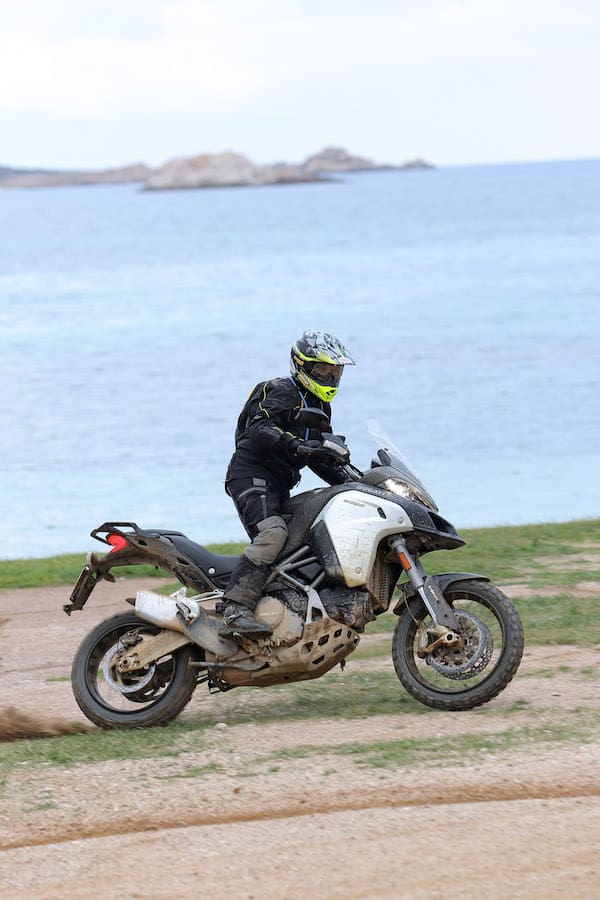
The wrap
How far the Multistrada Enduro will nibble into the adventure bike sales of the main players remains to be seen. Thirty thousand bucks is a lot of money to be throwing around in the dust and mud, and just how many of even the most die-hard Ducatistas will warm to the idea of a dirty desmo?… well, I guess we’ll just have to wait and see. I suspect most Multistrada Enduros will be used as high-end road tourers, with an occasional gravel side trip in mind. And for this, the Enduro is an enviable tool. But it will be a shame if at least a few don’t get roughed up a little.
Ducati’s debut in the premium adventure touring market is an impressive and welcome addition to a lively fight. And if you ever do catch sight of one scratched to buggery and covered in crap, make sure you give the lucky owner praise for giving it the abuse it was born for.

